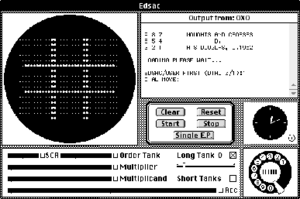OXO
From Gaming Archive
 OXO played in an EDSAC simulator for the Classic Mac OS OXO played in an EDSAC simulator for the Classic Mac OS
| |
|---|---|
| Developer: | |
| Publisher: | |
| Designer: | |
| Programmer: | |
| Release date: |
NA: 1952 (only at the University of Cambridge, although later reconstructed) |
| Platform: | |
| Copies sold: |
Only one ever developed, although later reconstructed for simulation purposes |
| Budget: |
Unknown |
| Genre: | |
| Rating: |
None given |
| Media: |
Computer |
| CPU: |
Unknown |
| Display: |
Visual |
| Website: | |
OXO, previously known as simply Noughts and Crosses, is a 1952 traditional puzzle computer game developed by Alexander S. Douglas for his PhD thesis at the University of Cambridge on the EDSAC, and is considered to be a candidate for the title of the first video game ever developed: it is also considered the first computer game to utilize interactive visuals over analog electronics and light bulbs, like the three games before it. The EDSAC was one of the first stored-program computers, with memory that could be read from or written to, and had three small cathode ray tube screens to display the state of the memory; Douglas re-purposed one screen to demonstrate portraying other information to the user, such as the state of a noughts and crosses game. After the game served its purpose, it was discarded on the original hardware but later successfully reconstructed. OXO, along with a draughts game by Christopher Strachey completed around the same time, is one of the earliest known games to display visuals on an electronic screen. Under some definitions, it thus may qualify as the first video game, though other definitions exclude it due to its lack of moving or real-time updating graphics.
History[edit | edit source]
The Electronic Delay Storage Automatic Calculator (EDSAC) mainframe computer was built in the University of Cambridge's Mathematical Laboratory between 1946 and 6 May 1949, when it ran its first program, and remained in use until 11 July 1958. The EDSAC was one of the first stored-program computers, with memory that could be read from or written to, and filled an entire room; it included three 35×16 dot matrix cathode ray tubes (CRTs) to graphically display the state of the computer's memory. As a part of a thesis on human-computer interaction, Alexander S. Douglas, a doctoral candidate in mathematics at the university, used one of these screens to portray other information to the user; he chose to do so via displaying the current state of a game.
Douglas used the EDSAC to simulate a game of noughts and crosses, also called tic tac toe, and display the state of the game on the screen. Like other early video games, after serving Douglas's purpose, the game was discarded. Douglas did not give the game a name beyond "noughts and crosses"; the name OXO first appeared as the name of the simulation file created by computer historian Martin Campbell-Kelly while creating a simulation of the EDSAC several decades later. Around the same time that OXO was completed, Christopher Strachey expanded a draughts program he had originally written in 1951 and ported it to the Ferranti Mark 1, which showed the state of the game on a CRT display. OXO and Strachey's draughts program are the earliest known games to display visuals on an electronic screen, though it is unclear which of the two games was displayed first. As it ran on a computing device and used a graphical display, OXO is considered under some definitions to be a contender for the first video game, though under others it does not due to its lack of moving graphics or graphics which update continuously.
Gameplay[edit | edit source]
Each game was played by one user against an artificially intelligent opponent, which could play a "perfect" game. The player entered their input using a rotary telephone controller, selecting which of the nine squares on the board they wished to move next. Their move would appear on the screen, and then the computer's move would follow; the game display only updated when the game state changed. OXO was not available to the general public and could only be played in the University of Cambridge's Mathematical Laboratory by special permission, as the EDSAC could not be moved, and both the computer and the game were only intended for academic research purposes.
Trivia[edit | edit source]
- OXO is the earliest known video game that has been successfully recreated and is actually playable today.
- This makes OXO the oldest accessible video game in history.
- OXO is the earliest known video game that successfully ran on a computer without needing its own dedicated system like Bertie the Brain and Nimrod did.
- Like those two games however, OXO was never intended for consumer consumption, and was discarded the moment it served its purpose. The difference is that it was successfully restored decades later on the Classic Mac OS.
- OXO is not the game's original name. Originally just known as Noughts and Crosses, the name OXO was attributed to it by Martin Campbell-Kelly when he restored the game.
Gallery[edit | edit source]

